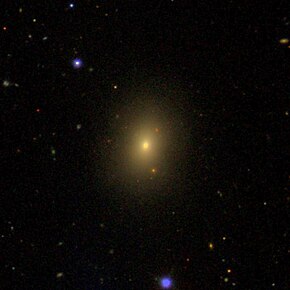| NGC 5004 | |
|---|---|
 | |
| Observation data (J2000 epoch) | |
| Constellation | Coma Berenices |
| Right ascension | 13h 11m 01.55s[1][2] |
| Declination | +29° 38′ 12.13″[1][2] |
| Redshift | 0.0235[1][2] |
| Distance | 324 Mly[2] |
| Characteristics | |
| Type | S0[1] |
| Apparent size (V) | 1.4' x 1.1'[2] |
| Other designations | |
| IRAS 13086+2950, LEDA 45756, MCG 05-31-149, UGC 8260[3] | |
NGC 5004 is a lenticular galaxy in the constellation Coma Berenices.[1][2] The object was discovered by astronomer William Herschel in 1785, using an 18.7-inch aperture reflector telescope. Due to its moderate apparent magnitude (+13), it is visible only with amateur telescopes or with superior equipment.
One supernova has been observed in NGC 5004: SN 1976A (type unknown, mag. 16.5).[4]
References[edit]
- ^ a b c d e "NASA/IPAC Extragalactic Database". Results for NGC 5004. Retrieved November 26, 2022.
- ^ a b c d e f "Galaxy NGC 5004 - Lenticular Galaxy in Coma Berenices Constellation". Telescopius. Retrieved November 26, 2022.
- ^ "NGC 5004". SIMBAD. Retrieved November 26, 2022.
- ^ Transient Name Server entry for SN 1976A. Retrieved 29 March 2023.
External links[edit]
 Media related to NGC 5004 at Wikimedia Commons
Media related to NGC 5004 at Wikimedia Commons- NGC 5004 on WikiSky: DSS2, SDSS, GALEX, IRAS, Hydrogen α, X-Ray, Astrophoto, Sky Map, Articles and images
Well, that’s interesting to know that Psilotum nudum are known as whisk ferns. Psilotum nudum is the commoner species of the two. While the P. flaccidum is a rare species and is found in the tropical islands. Both the species are usually epiphytic in habit and grow upon tree ferns. These species may also be terrestrial and grow in humus or in the crevices of the rocks.
View the detailed Guide of Psilotum nudum: Detailed Study Of Psilotum Nudum (Whisk Fern), Classification, Anatomy, Reproduction